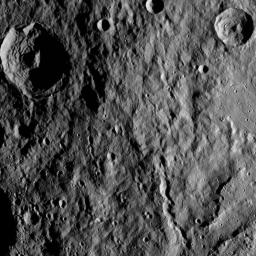
|
Dawn HAMO Image 63
- Click the image above for a larger view
- Full-Res JPEG (1024 x 1024) (232.3 kB)
- Full-Res TIFF (1024 x 1024) (1.1 MB)
Caption:
This image of Ceres from NASA's Dawn spacecraft shows hummocky terrain -- a surface covered in low, rounded hills -- with numerous impact craters of varying sizes. The two biggest craters display central peaks and many places where masses of material have collapsed and slid downward along their walls and floors -- a phenomenon geologists call "mass wasting".
The sharp crater at upper right is surrounded by smooth ejecta with a streaky texture to the south. A graben -- what geologists call a linear feature where terrain has dropped -- measuring 2 to 5 miles (3 to 8 kilometers) in width, and two prominent scarps, or linear, cliff-like slopes, are located in the southeastern (lower right) part of the image.
Dawn took this image on Oct. 5, 2015, from an altitude of 915 miles (1,470 kilometers). It has a resolution of 450 feet (140 meters) per pixel.
Background Info:
Dawn's mission is managed by JPL for NASA's Science Mission Directorate in Washington. Dawn is a project of the directorate's Discovery Program, managed by NASA's Marshall Space Flight Center in Huntsville, Alabama. UCLA is responsible for overall Dawn mission science. Orbital ATK, Inc., in Dulles, Virginia, designed and built the spacecraft. The German Aerospace Center, the Max Planck Institute for Solar System Research, the Italian Space Agency and the Italian National Astrophysical Institute are international partners on the mission team. For a complete list of acknowledgments, see http://dawn.jpl.nasa.gov/mission .
For more information about the Dawn mission, visit http://dawn.jpl.nasa.gov .
Cataloging Keywords:
| Name | Value | Additional Values |
|---|---|---|
| Target | 1 Ceres | |
| System | Main Belt | |
| Target Type | Dwarf Planet | Asteroid |
| Mission | Dawn | |
| Instrument Host | Dawn | |
| Host Type | Orbiter | |
| Instrument | Framing Camera (FC) | |
| Detector | ||
| Extra Keywords | Crater, Grayscale, Impact | |
| Acquisition Date | ||
| Release Date | 2015-11-19 | |
| Date in Caption | 2015-10-05 | |
| Image Credit | NASA/JPL-Caltech/UCLA/MPS/DLR/IDA | |
| Source | photojournal.jpl.nasa.gov/catalog/PIA20125 | |
| Identifier | PIA20125 | |
